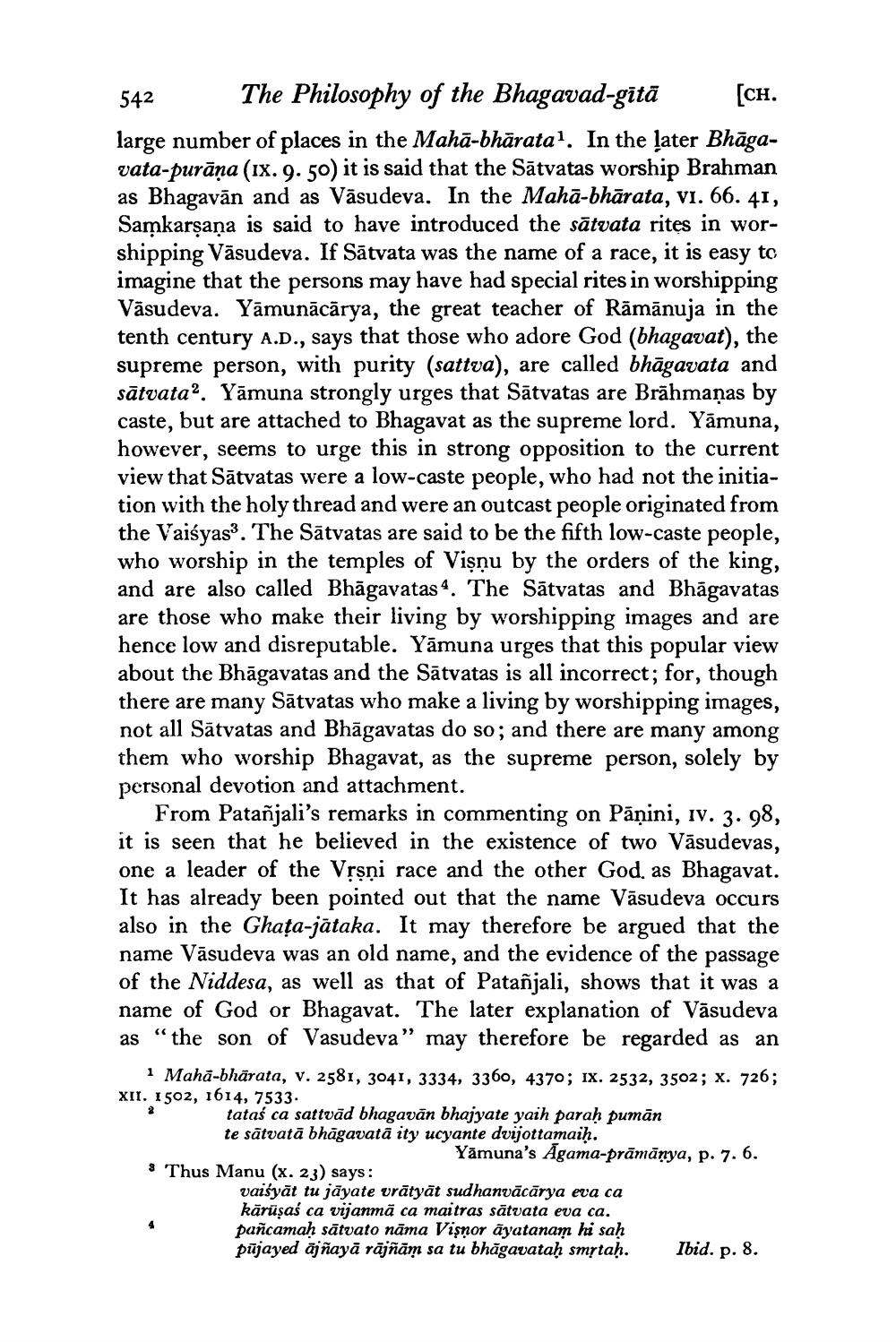________________
542 The Philosophy of the Bhagavad-gītā [CH. large number of places in the Maha-bhāratal. In the later Bhāgavata-purāņa (1x. 9.50) it is said that the Sātvatas worship Brahman as Bhagavān and as Vāsudeva. In the Mahā-bhārata, vi. 66. 41, Samkarşana is said to have introduced the sātvata rites in worshipping Väsudeva. If Sātvata was the name of a race, it is easy to imagine that the persons may have had special rites in worshipping Vāsudeva. Yāmunācārya, the great teacher of Rāmānuja in the tenth century A.D., says that those who adore God (bhagavat), the supreme person, with purity (sattva), are called bhāgavata and sātvata2. Yāmuna strongly urges that Sātvatas are Brāhmanas by caste, but are attached to Bhagavat as the supreme lord. Yāmuna, however, seems to urge this in strong opposition to the current view that Sātvatas were a low-caste people, who had not the initiation with the holy thread and were an outcast people originated from the Vaisyas?. The Sātvatas are said to be the fifth low-caste people, who worship in the temples of Vişņu by the orders of the king, and are also called Bhāgavatas 4. The Sātvatas and Bhāgavatas are those who make their living by worshipping images and are hence low and disreputable. Yāmuna urges that this popular view about the Bhāgavatas and the Sātvatas is all incorrect; for, though there are many Sātvatas who make a living by worshipping images, not all Sätvatas and Bhāgavatas do so; and there are many among them who worship Bhagavat, as the supreme person, solely by personal devotion and attachment.
From Patañjali's remarks in commenting on Pāṇini, iv. 3. 98, it is seen that he believed in the existence of two Vāsudevas, one a leader of the Vrsni race and the other God, as Bhagavat. It has already been pointed out that the name Vāsudeva occurs also in the Ghața-jātaka. It may therefore be argued that the name Vāsudeva was an old name, and the evidence of the passage of the Niddesa, as well as that of Patañjali, shows that it was a name of God or Bhagavat. The later explanation of Vāsudeva as “the son of Vasudeva” may therefore be regarded as an
1 Mahā-bhärata, v. 2581, 3041, 3334, 3360, 4370; ix. 2532, 3502; x. 726; XII. 1502, 1614, 7533.
tataś ca sattvād bhagavan bhajyate yaih parah pumān te sātvatā bhāgavatā ity ucyante dvijottamaih.
Yāmuna's Āgama-prāmānya, p. 7. 6. 8 Thus Manu (x. 23) says:
vaiśyāt tu jāyate urātyāt sudhanvācārya eva ca kārüşaś ca vijanmā ca maitras sātvata eva ca. pañcamaḥ sātvato nāma Vişnor āyatanam hi sah pūjayed ajñayā rājñām sa tu bhāgavataḥ smytah. Ibid. p. 8.




